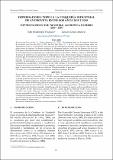Por favor, use este identificador para citar o enlazar este ítem:
https://hdl.handle.net/20.500.12958/4877Registro completo de metadatos
| Campo DC | Valor | Lengua/Idioma |
|---|---|---|
| dc.contributor.author | Rivadeneyra-Villafuerte, Sofía | - |
| dc.contributor.author | Román-Amancio, Gersson | - |
| dc.date.accessioned | 2022-09-14T14:31:38Z | - |
| dc.date.available | 2022-09-14T14:31:38Z | - |
| dc.date.issued | 2022-06 | - |
| dc.identifier.citation | Rivadeneyra-Villafuerte, S., Román-Amancio, G. (2022). Depredadores tope en la pesquería industrial de anchoveta entre los años 2015 y 2019. Bol Inst Mar Perú. 37(1): 91-112. | es_ES |
| dc.identifier.issn | 04587766 | - |
| dc.identifier.uri | https://hdl.handle.net/20.500.12958/4877 | - |
| dc.description.abstract | Las interacciones entre los depredadores tope y las pesquerías suponen una problemática global que tiene impacto sobre diversas poblaciones de especies de interés ecológico. El Programa Bitácoras de Pesca del Instituto del Mar del Perú aporta información sobre estas interacciones mediante la observación directa de los lances de pesca de las embarcaciones industriales de anchoveta. Entre los años 2015 y 2019 se realizaron 12.778 lances de pesca de anchoveta con presencia de depredadores tope, observándose mayor existencia de aves marinas que de mamíferos marinos, y se destaca el zarcillo Larosterna inca (26,69% del total de los lances), pelícano Pelecanus thagus (24,44%), piquero peruano Sula variegata (22,95%) y lobo chusco Otaria flavescens (36,69%). La distribución de aves y mamíferos marinos a lo largo de la costa peruana estuvo asociada a la plataforma continental y a la presencia de mayores colonias en la costa norte – centro. Es importante destacar que entre los años 2015 y 2016 se registró la menor cantidad de avistamientos de depredadores tope, lo que estaría relacionado con el evento El Niño ocurrido en esos años. | es_ES |
| dc.description.abstract | ABSTRACT: Interactions between top predators and fisheries pose a global problem that has an impact on different populations of ecologically important species. The IMARPE’s Fishing Logbooks Program provides important information on these interactions through direct observation of the fishing lances of industrial anchovy vessels. A total of 12,778 anchoveta fishing hauls were made between 2015 and 2019 with the presence of top predators. Seabirds were the most important group in terms of number of sightings, and the presence of species such as zarcillo Larosterna inca (26.69% of the total hauls), pelican Pelecanus thagus (24.44%), Peruvian booby Sula variegata (22.95%) and south American sea lion Otaria flavescens (36.69%). The distribution of seabirds and marine mammals along the Peruvian coast was associated with the continental shelf and the presence of important colonies on the north-central coast. It is important to highlight that between the years 2015 and 2016 the fewest top predator sightings were recorded, which would be related to the El Niño event that occurred in those years. | - |
| dc.language.iso | spa | es_ES |
| dc.publisher | Instituto del Mar del Perú | es_ES |
| dc.relation.ispartofseries | Boletín IMARPE 37(1), 2022; | - |
| dc.rights | info:eu-repo/semantics/openAccess | es_ES |
| dc.rights.uri | https://creativecommons.org/licenses/by/4.0/ | es_ES |
| dc.source | Instituto del Mar del Perú - IMARPE | es_ES |
| dc.source.uri | Repositorio Digital IMARPE | es_ES |
| dc.subject | Aves marinas | es_ES |
| dc.subject | Mamíferos marinos | es_ES |
| dc.subject | El Niño | es_ES |
| dc.title | Depredadores tope en la pesquería industrial de anchoveta entre los años 2015 y 2019 | es_ES |
| dc.title.alternative | Top predators in the industrial anchoveta fisheries (2015 – 2019) | es_ES |
| dc.type | info:eu-repo/semantics/article | es_ES |
| dc.publisher.country | Perú - Callao | es_ES |
| dc.subject.ocde | http://purl.org/pe-repo/ocde/ford#1.05.11 | es_ES |
| Aparece en las colecciones: | Boletín 37(1) 2022 | |
Ficheros en este ítem:
| Fichero | Descripción | Tamaño | Formato | |
|---|---|---|---|---|
| Boletin 37-1 artículo 6.pdf | 789,58 kB | Adobe PDF |  Visualizar/Abrir |
Este ítem está sujeto a una licencia Creative Commons Licencia Creative Commons

